I had to grind some steel shoes to fit this curved stringer today. I love figuring angles and I knew that just one simple cut of the shoe would not fit perfectly to the curb. But what is the angle difference and how much gap would there be if I did just cut the angle to one side? Thats the questions I fed to my trig calculator.
The balusters shoes are 1.3125 inches wide. The inclination angles on a stairway get shallower as you go from the center to the outside.
The smaller inside radius of this shoe is 36.0 inches. Thus the outside radius is 37.3125 inches. The angle of inclination on the inside is 47.168 degrees…..and this angle is shallower on the outside of the shoe…and it computes to 46.144 degrees.
Taking the tangent of each angle, I arrive at 1.07869 for the inside face…and 1.04075 for the outside face.
One just has to multiply these tangents by the width of the shoe which is 1.3125 inches….to find the height of the bevel that needs to be cut off.
I came up with 1.416 inches for the inside..and a shallower bevel for the other side at 1.366 inches.
This shows a difference of right at 0.050 inches…which is close to a 16th of an an inch. Thats a pretty big difference to most finish carpenters…and especially at something that draws your eye close.
I set up a jig to cut the inside angle…by the way…no…I do not have the capabilities to actually cut this thing to those thousandths of a degree of course…but those figures are my guidelines to show the difference that needs to be ground across the two faces of the shoes.
After the cut….I simply ground the other side slightly shallower, and just a stab or two and it was fitting nice on the helical surface that my curb stringer has.
This may be to some like splitting hairs….but believe me it is not. You should just see the difference or feel it by trying just a simple one angle cut.
The outside rail is next as this is a freestanding stairway. The outside forms will be stripped away Monday.
Stan

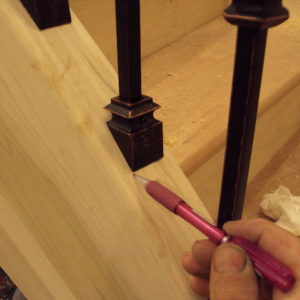

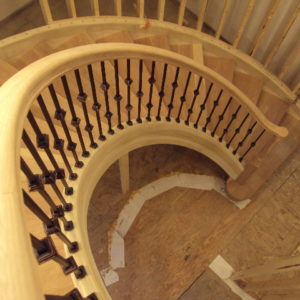

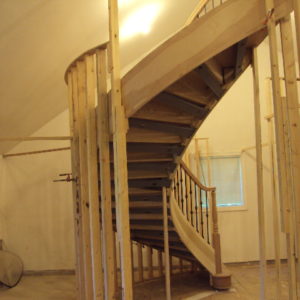

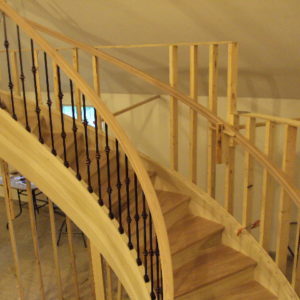
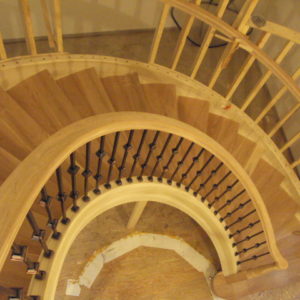




















Replies
Very Nice Stan. Do you use a metal cutting bandsaw for the iron shoe?
I use a "Portaband" for cutting iron balusters and shoe. Much quieter and cleaner and no sparks... compared to a metal cutoff chop saw. Safer too, especially for cutting shoe. Then touchup on the bench grinder.
basswood- I have a 14 inch cutoff saw that I use. I have the angle jigged in...and a block of wood with a screw protruding to lock into the ornamental detail of the shoe. I then clamp and cut to the inside steepest angle. The other side is then hand ground to that one degree less angle. If it fits nice..then its installed.
Stan
I see. The metal cutting bandsaw (even my portaband) has an oil bath keeping the blade clean and cool. Cuts iron like the proverbial hot knife through butter. Maybe not quite as fast as a cutoff saw, but I like the quiet and clean cutting. Just another option... especially for a nice shop like yours.
basswood- I am sure your method is cleaner...quieter...and just as accurate. I have only had a curbed stairway with iron balusters once before...and on that one...the angle that the shoes were cast at fit nicely. This is the first time for me cutting these shoes...so if it comes up again...I will consider your advice......thanks!
Stan
Might be worth investing in... if the right job comes along. I do like things to be clean and quiet... maybe I'm in the wrong field ;o) Free advise is sure to be worth at least what you paid for it.
Except when you are coping.
Touche!I still like using a coping saw for just a cope or two.
A coping saw is one of my tools I enjoy using.
Nicely done Stan, glad you can post pics again.
Do you also calculate the helical distance for rail length and baluster spacing?
mathewson- I will generally just plumb up each individual one, or sometimes plub up the end ones...and divide out the angled length.
I do try a variety of ways...mathematical..and practical...just to keep it more interesting and to keep my math skills sharper.
Stan